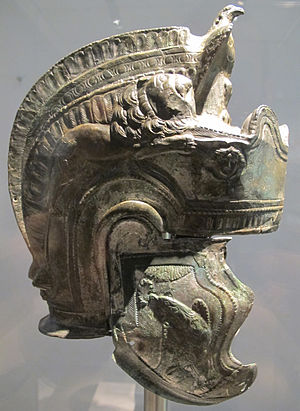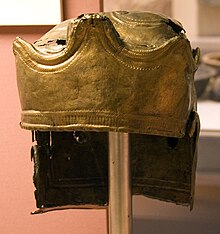Guisborough-Theilenhofen (helmet)
| Guisborough-Theilenhofen (helmet) | |
|---|---|

|
|
| Information | |
| Weapon type: | Protective weapon |
| Designations: | Guisborough-Theilenhofen type |
| Use: | helmet |
| Working time: | 2nd half of 2nd century AD to 1st half of 3rd century AD |
| Distribution: | Roman Empire |
| Lists on the subject | |
The Roman helmet type Guisborough-Theilenhofen is regarded by most scientists as a maskless so-called parade helmet of the auxiliary troops, as it was used in the standardized equestrian exercises of the cavalry. Others, on the other hand, see the piece as a regular combat helmet from the middle imperial era. It was named after the two most important representatives of this type in Guisborough, England, and in the camp village ( Vicus ) of the Rhaetian Limes Fort Theilenhofen (Iciniacum) .
Scientifically proven helmets of this extremely rare type were also found in the Gallic Cabillonum Chalon-sur-Saône , at the Upper Pannonian Danube fort Gerulata and in the Transylvanian Kaltherberg (Războieni-Cetate).
The Theilenhofen helmet
The helmet, which emerged from the ground in 1974 during a plowing competition in the fort vicus of Theilenhofen ( Weißenburg-Gunzenhausen district ) as the most spectacular militaria find to date, is lavishly decorated with drifting work and was the only one of its kind to be completely reconstructable. In addition to the Guisborough helmet, there was a similar, not so well preserved piece, which, unlike the Theilenhofen helmet, had two eagle protomes , in the private collection of Axel Guttmann from Berlin , which was auctioned after his death. Pieces of low material thickness such as the helmet made from Iciniacum are mainly viewed in research as pure, so-called parade helmets , which were not actually intended for military use, but were worn during the regularly held, standardized equestrian exercises ("tournaments") of the cavalry should make the current level of training clear. The “Equestrian Tract of Flavius Arrianus” from the year 136 AD is the first source for these exercises today.
On the helmet shell from Theilenhofen there are three short-feathered combs standing next to each other. The two smaller of these crests, on the right and left above the ear protection, are each assigned a jumping lion, while the central crest ends in an eagle protome that stands over a high forehead protection. The neck protection is, as is usual with the older Roman cavalry helmets of the 1st century AD, only indicated very briefly. The Roman eagle with the laurel in its beak is depicted on the broad cheek pieces. The material used is brass bronze , which is partially coated with white metal to increase the visual appeal. The rider's helmet has a narrow neck visor and wide cut-out openings for the ears, which are covered by cheek flaps. Latin owner inscriptions are hallmarked behind the ear protection and on the headband , which indicate the respective squadron ( tower ) of the wearer. On the basis of the inscriptions it was established that the helmet was worn one after the other by five cavalrymen from the Cohors III Bracaraugustanorum equitata (3rd partially mounted cohort from Bracara Augusta ) stationed in Theilenhofen , which suggests a longer use. The cheek flaps reach below the chin and are doubly wavy on the front. On their flanks there is an image of an eagle holding a laurel wreath in its beak . Over the forehead area of the dome sits a simulated forehead visor, which has a triple corrugated, flanged edge towards the top. Over the helmet bell, from the top of the head to the rear helmet, which is drawn far down, run three metal combs sitting next to each other, which are designed differently. The middle crest lies on the top of the helmet, it is divided into three longitudinal sections and decorated with stylized representations of bird feathers . At the front end, the crest is designed as an eagle protome. The other two ridges run on either side of the middle ridge and end at the front with a representation of lions .
The Theilenhofener helmet - a late representative of the early imperial pseudo-Attic type Koblenz-Bubenheim-Weiler - was restored and partially supplemented in the restoration workshops of the Roman-Germanic Central Museum in Mainz . After it was initially exhibited in the Prehistoric State Collection in Munich , it is now in the Germanic National Museum in Nuremberg . A helmet of the same type is the Guisborough helmet, which only differs in the decoration (picture on the right). Its reconstruction is not complete.
The helmet is an example of the military's historicizing approach to its own past. It is known of Roman militaria that they often resorted to forms that were already older and no longer in use at the time, in order to “benefit from the prestige of the classical model”. Something similar can still be seen today in the military in many countries, who wear historical or historicizing uniforms to parades.
The time of origin of the piece is probably in the 2nd half of the 2nd century AD. The place where it was found, a building destroyed by fire in the Theilenhofen camp village, was certainly destroyed after 189 AD, perhaps not until the 3rd century. It may have got into the ground with the Alemanni invasion of 233.
use
As the archaeologist Thomas Fischer emphasized in 1991, the hallmarked owner inscriptions do not give any indication that the helmet could have been used by officers, since they only name simple riders. Fischer also saw the piece as a normal cavalry combat helmet. This opinion shared among others Markus Egg and Götz Waurick from the Roman-Germanic Central Museum. The historian and experimental archaeologist Marcus Junkelmann, in turn, pleaded for an object used in equestrian exercises. Martin Kemkes , director of the Limes Museum in Aalen , and Jörg Scheuerbrandt , director of the Römermuseum Osterburken , decided to be assigned as a parade helmet , among other things with reference to the very thin material thickness of only 1.5 to 0.2 millimeters . In this sense, it is also presented today in the Germanic National Museum.
literature
- Hans Klumbach , Ludwig Wamser : A new find of two extraordinary helmets from the Roman Empire from Theilenhofen, Weißenburg-Gunzenhausen district. A preliminary report. In: Annual Report of the Bavarian Heritage Monument Care 17/18 (1978), pp. 41–61.
- Jochen Garbsch : Roman parade armor. Exhibition catalog of the Germanic National Museum Nuremberg and the Prehistoric State Collection Munich. CH Beck Verlag, Munich 1978, ISBN 3-406-07259-3 .
- Günther Bräutigam: Treasury of the Germans. From the collections of the Germanisches Nationalmuseum Nürnberg. Germanisches Nationalmuseum, Nuremberg 1982, p. 23.
- Hermann Born, Marcus Junkelmann : Roman combat and tournament armor (= Axel Guttmann Collection. Vol. 6). Verlag Sammlung Guttmann at Verlag Philipp von Zabern, Mainz 1997, ISBN 3-8053-1668-2 , pp. 66, 111.
- Martin Kemkes , Jörg Scheuerbrandt : Between patrol and parade. The Roman cavalry on the Limes (= writings of the Limes Museum Aalen. Vol. 51). Konrad Theiss Verlag, Stuttgart 1997, ISBN 3-8062-1440-9 .
Web links
Remarks
- ↑ Eduard Krekovič, Ladislaus Snopko: The Roman pomp helmet of Gerulata. In: Archaeological correspondence sheet. Vol. 28, 1998, ISSN 0342-734X , pp. 283-296, here p. 284.
- ↑ Johannes Willers, Georg Ulrich Großmann a. a .: Germanisches Nationalmuseum. Guide to the collections. Germanisches Nationalmuseum, Nuremberg 2001, p. 25.
- ↑ Marcus Junkelmann: Roman helmets. (= Axel Guttmann Collection, Vol. 8). Verlag Sammlung Guttmann bei von Zabern Mainz 2000, ISBN 3-8053-1670-4 , pp. 161–162; Helmet fragment from the Guttmann Collection in the Arachne archaeological database ; Helmet fragment from the Guttmann Collection in the Arachne archaeological database .
- ↑ Marcus Junkelmann: Riders like statues from ore. Verlag Philipp von Zabern, Mainz 1996, ISBN 3-8053-1819-7 , p. 88.
- ↑ Marcus Junkelmann : The Legions of Augustus. Verlag Philipp von Zabern, Mainz 1986, ISBN 3-8053-0886-8 , p. 170.
- ^ Germanic National Museum Nuremberg, Theilenhofener Helm , accessed on September 20, 2016.
- ↑ Marcus Junkelmann: The Legions of Augustus. Verlag Philipp von Zabern, Mainz 1986, ISBN 3-8053-0886-8 , p. 170.
- ^ A b Marcus Junkelmann: The riders of Rome, part III . Verlag Philipp von Zabern, Mainz 1992, ISBN 3-8053-1288-1 , p. 161 u. 194.
- ^ Fasti archaeologici. Annual Bulletin of Classical Archeology . Volume 34-35, 1979-1980, p. 1125.
- ↑ Gabrielle Kremer: An emperor in Jupiter robe from Pfaffenberg. In: Carnuntum-Jahrbuch 1996, pp. 39-58; here: p. 52
- ↑ Martin Kemkes , Jörg Scheuerbrandt : Between patrol and parade. The Roman cavalry on the Limes (= writings of the Limes Museum Aalen. Vol. 51). Konrad Theiss Verlag, Stuttgart 1997, ISBN 3-8062-1440-9 . P. 57.
